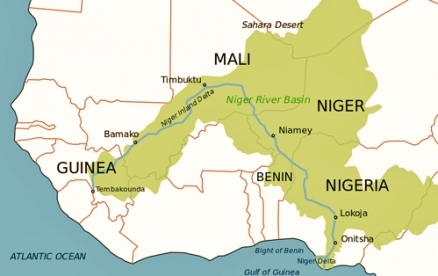Niger River
The Niger River is the third largest river in Africa, and the fourteenth longest river in the world. Rising in the Guinea Highlands, the river flows 4200 kilometres through Guinea, Mali, Niger (including along the border with Benin), and Nigeria, before discharging in the expansive Niger Delta on the Gulf of Guinea. The river flows in an unusual course, since it rises not far from the Atlantic Ocean, but takes a northeasterly course toward the Sahara Desert, before turning southeast to eventually discharge to the Atlantic in Nigeria.
The Niger Basin is comprised of very diverse ecoregions (Ecoregions) ranging from the arid Sahel to the extremely wet coastal Niger Delta. Sizable parts of the basin generate essentially no surface runoff, and are thus classified as [arheic]. There is a very diverse reptilian and mammalian fauna, as well as fish species that are quite diverse, the fish taxa containing a number of endemics.
Contents
Upper reach
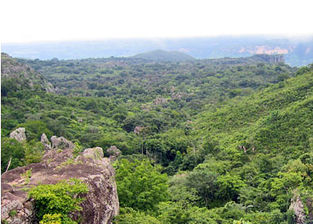 Niger headwaters Djalon area of Guinean Highlands. Source: Michel Tendil The Niger River rises in the Guinean Highlands immediately east of Tembakounda on rock substrate that yields littel silt load. Correspondingly the clarity of the Niger is relatively high without much initial turbidity. The upper reach discharges into the Inland Niger Delta, after draining relatively modest headwater catchments in the Guinean forest-savanna mosaic and West Sudanian savanna ecoregions.
Niger headwaters Djalon area of Guinean Highlands. Source: Michel Tendil The Niger River rises in the Guinean Highlands immediately east of Tembakounda on rock substrate that yields littel silt load. Correspondingly the clarity of the Niger is relatively high without much initial turbidity. The upper reach discharges into the Inland Niger Delta, after draining relatively modest headwater catchments in the Guinean forest-savanna mosaic and West Sudanian savanna ecoregions.
Part way into the West Sudanian savanna the Inland Niger Delta commences, which is a vast expanse of lakes, braided channels and marshes, exemplifying a seasonal flooding peak each September to December, lagging the rainy season end in September. At flood stage the river is often more than four kilometres in width. There is an enormous water loss of the Niger flow in this inland delta, where annually about thirty cubic kilometres of water are lost to evaporation and seepage.
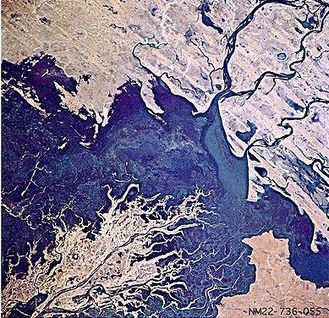 A portion of the Inland Niger River delta at flood stage. Source: NASA The initial element reached by the Niger River as it enters the inland delta is an expansive floodplain dominated by grasses and aquatic plants. Key grasses are: Acroceras amplectens; Antelope Grass (Echinochloa pyramidalis), Hippo Grass (Echinochloa stagnina) and Thalia Lovegrass (Eragrostis atrovirens).
A portion of the Inland Niger River delta at flood stage. Source: NASA The initial element reached by the Niger River as it enters the inland delta is an expansive floodplain dominated by grasses and aquatic plants. Key grasses are: Acroceras amplectens; Antelope Grass (Echinochloa pyramidalis), Hippo Grass (Echinochloa stagnina) and Thalia Lovegrass (Eragrostis atrovirens).
At the margin of the inland delta floodplains different grasses dominate, such as Scutch Grass (Cynodon dactylon), Bluestem Grass (Andropogon gayanus), and Yellow Thatching Grass (Hyperthelia dissoluta). Along the braided channel riparian areas tree growth much more profuse than on the savanna away from the riparian zone, including an understory of the sedge Cyperus macuatus. And the inland delta has several notable fish; the upside-down catfish Synodontis gobroni is endemic to the Niger Basin as is the cichlid, Gobiocichla wonderi.
In the final stretch of the inland delta there are emergent sand ridges that nurture the Doum Palm Tree (Hyphaene thebaica) and the Palmyra Palm (Borassus aethiopum), along with other woody plants such as the Indian Jujube (Ziziphus mauritiana) and Guiera senegalensis.
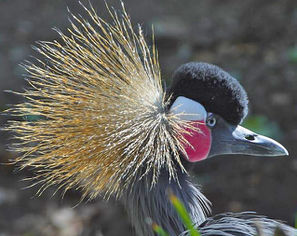 West African Black Crowned Crane. Source: Ivo Antušek/BioLib/EoL The inland delta of the Niger is a major source of sustainance for large flocks of migrating and resident avafauna, including taxa such as the Endangered West African Black Crowned Crane (Balearica pavonina pavonina). An important refugium for the African Manatee is found here, who consumes submerged vegetation.
West African Black Crowned Crane. Source: Ivo Antušek/BioLib/EoL The inland delta of the Niger is a major source of sustainance for large flocks of migrating and resident avafauna, including taxa such as the Endangered West African Black Crowned Crane (Balearica pavonina pavonina). An important refugium for the African Manatee is found here, who consumes submerged vegetation.
TheWest Sudanian savanna is present in parts of both the upper and lower reaches of the Niger Basin. In the upper reach of the Niger Basin, the Mali Screeching Frog (Arthroleptis milletihorsini) is endemic to southeastern Mali and endemic to the West Sudanian savanna.
The Sahelian acacia savanna is only marginally valuable for agriculture, but the expanding human population here is imposing pressures on habitat by overgrazing and inappropriate cropping practises, over leading to erosion and aggravating relentless desertification in this stretch of the Niger Basin. Endemic mammals of the Sahelian acacia savanna include one bat species, Eptesicus floweri, and two gerbils: Petter's Tateril (Taterillus petteri) and Senegal Tateril (T. pygargus). T. petteri can also be regarded as a Niger Basin endemic; moreover, it occurs only on the right bank, emphasizing the severity of the zoographic barrier of the Niger above its coastal delta. However, the Senegal Tateril, while endemic to the Sahelian acacia savanna ecoregion, has a disjunctive population outside of the Niger Basin in Senegal.
Lower reach
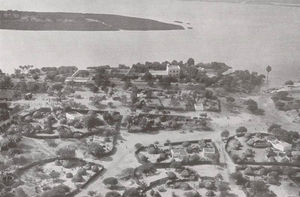 Niger River at the town of Niamey. Source: Walter Mittelholzer. 1930 The lower reach of the Niger River can be defined as the segment that flows southeast beginning somewhat above Niamey in Niger and discharging to the Atlantic through the Niger Delta. This segment is deemed by some to have been a separate ancient river from the present day Niger headwaters, prior to joining of the two primordial basins around the time that the Sahara Desert was in sever desiccation, roughly three to six thousand years ago. The beginning of this lower reach was important in ancient history, since this point marked the closest incursion of any major North African River to the Sahara Desert. This this locus was a controlling point of the historic Sahara caravan routes where Arabs brought salt to the Kingdom of Mali and returned with gold and slaves.
Niger River at the town of Niamey. Source: Walter Mittelholzer. 1930 The lower reach of the Niger River can be defined as the segment that flows southeast beginning somewhat above Niamey in Niger and discharging to the Atlantic through the Niger Delta. This segment is deemed by some to have been a separate ancient river from the present day Niger headwaters, prior to joining of the two primordial basins around the time that the Sahara Desert was in sever desiccation, roughly three to six thousand years ago. The beginning of this lower reach was important in ancient history, since this point marked the closest incursion of any major North African River to the Sahara Desert. This this locus was a controlling point of the historic Sahara caravan routes where Arabs brought salt to the Kingdom of Mali and returned with gold and slaves.
This lower reach runs through the following ecoregions which are severely stratified and run in an east-west direction:
- Sahelian acacia savanna
- West Sudanian savanna
- Guinean forest-savanna mosaic
- Cross-Niger transition forests
This progression of ecoregions marks the expected alteration of the Sahel's alternating wet and dry season savanna to tropical rainforests that receive steadily more precipitation as one proceeds southward in West Africa.
TheWest Sudanian savanna is relatively poor in faunal endemism, although there are three bird species regarded near-endemic: Long-tailed Cisticola (Cisticola dorsti, DD), White-crowned Robin-chat (Cossypha albicapilla) and Mali Firefinch (Lagonosticta virata). The last of these is mainly associated with the Inner Niger Delta swamps. A near endemic mammal of this ecoregion is the Senegal One-striped Grass Mouse (Lemniscomys linulus). Note that many of the fauna found in the lower reach within the West Sudanian savanna can also be found in the upper reach where the same ecoregion re-appears.
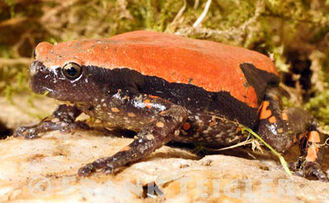 West African Rubber Frog. Source: Frank Teigler/CalPhotos/EoL Amphibians found in the West Sudanian savanna ecoregion include the endemic Bata Marsh toad (Amietophrynus chudeaui), the West African Rubber Frog (Phrynomantis microps), the Pale Running Frog (Kassina fusca), the Silver Running Frog (Kassina cassinoides), the Buea Screeching Frog (Arthroleptis variabilis), the Central Grassland Frog (Ptychadena tellinii), Dakar Grassland Frog (Ptychadena trinodis), the Broad-banded Grassland Frog (Ptychadena bibroni), the Sudan Ridged Frog (Ptychadena schillukorum), the Marbled Snout Burrower (Hemisus marmoratus), the Muller's Clawed Frog (Xenopus muelleri), the Natal Dwarf Puddle Frog (Phrynobatrachus natalensis), Rusty Forest Treefrog (Leptopelis viridis), Savanna Forest Treefrog (Leptopelis bufonides), and Weidholz's Banana Frog (Afrixalus weidholzi).
West African Rubber Frog. Source: Frank Teigler/CalPhotos/EoL Amphibians found in the West Sudanian savanna ecoregion include the endemic Bata Marsh toad (Amietophrynus chudeaui), the West African Rubber Frog (Phrynomantis microps), the Pale Running Frog (Kassina fusca), the Silver Running Frog (Kassina cassinoides), the Buea Screeching Frog (Arthroleptis variabilis), the Central Grassland Frog (Ptychadena tellinii), Dakar Grassland Frog (Ptychadena trinodis), the Broad-banded Grassland Frog (Ptychadena bibroni), the Sudan Ridged Frog (Ptychadena schillukorum), the Marbled Snout Burrower (Hemisus marmoratus), the Muller's Clawed Frog (Xenopus muelleri), the Natal Dwarf Puddle Frog (Phrynobatrachus natalensis), Rusty Forest Treefrog (Leptopelis viridis), Savanna Forest Treefrog (Leptopelis bufonides), and Weidholz's Banana Frog (Afrixalus weidholzi).
The Cross-Niger transition forests comprises only a minute portion of the lower reach catchment of the Niger River. It represents a region of dense human habitation and severely degraded forest. Species richness and endemism are also quite low, with the Crested Chameleon (Chamaeleo cristatus) one of the few near-endemics to the ecoregion. This lowest reach of the river prior to the delta also marks the locus where the Niger River is still a major zoogeographic barrier, unlike the delta where the braided distributary system provides much less a barrier to faunal movement.
Niger Delta
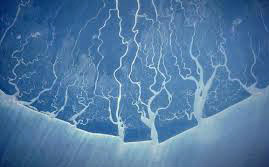 Niger Delta from space. Source: NASA The Niger Delta is an enormous classic distributary system, which stretches more than 300 kilometres wide and serves to capture most of the heavy silt load carried by the Niger. The peak discharge at the mouth is around 21,800 cubic metres per second in mid-October. Major ecological threats to the delta ecology are the rapidly expanding human population and associated land clearance for agriculture and salt pans, as well as water pollution from the oil industry. The Niger Delta coastal region is arguably the wettest place in Africa with an annual rainfall of over 4000 millimetres. Vertebrate species richness is relatively high in the Niger Delta, although vertebrate endemism is quite low.
Niger Delta from space. Source: NASA The Niger Delta is an enormous classic distributary system, which stretches more than 300 kilometres wide and serves to capture most of the heavy silt load carried by the Niger. The peak discharge at the mouth is around 21,800 cubic metres per second in mid-October. Major ecological threats to the delta ecology are the rapidly expanding human population and associated land clearance for agriculture and salt pans, as well as water pollution from the oil industry. The Niger Delta coastal region is arguably the wettest place in Africa with an annual rainfall of over 4000 millimetres. Vertebrate species richness is relatively high in the Niger Delta, although vertebrate endemism is quite low.
Upper coastal delta
The Niger Delta swamp forests occupy the entire upper coastal delta. Historically the most important timber species of the inner delta was the Abura (Fleroya ledermannii), a Vulnerable swamp-loving West African tree, which has been reduced below populations viable for timber harvesting in the Niger Delta due to recent over-harvesting of this species as well as general habitat destruction of the delta due to the expanding human population here. Other plants prominent in the inner delta flood forest are: the Azobe tree (Lophira alata), the Okhuen tree (Ricinodendron heudelotii ), the Bitter Bark Tree (Sacoglottis gabonensis), the Rough-barked Flat-top Tree (Albizia adianthifolia), and Pycnanthus angolensis. Also present in its native range is the African Oil Palm (Elaeis guineensis), whose introduction as a crop in Borneo and other locales has proven to be an ecological disaster due to habitat replacement; over-reliance on this as a monocultural crop in the Niger Delta also threatens the habitat here. All ot these trees are tolerant of the annual inundation period of the lower inner delta. Understory in the flood forest zone is dominated by the Senegal Clustering Rattan (Calamus deerratus).
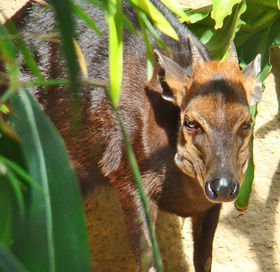 Black Duiker. Source: Mario Pineda There are a number of notable mammals present in the upper coastal delta, including the Critically Endangered Niger Delta Red Colubus (Procolobus pennantii ssp. epieni), which primate is endemic to the Niger Delta. The near-endemic White-cheeked Guenon (Cercopithecus erythrogaster, VU) is found in the inner delta. The Endangered Chimpanzee (Pan troglodytes) is also found in the inner delta. The limited range Black Duiker (Cephalophus niger) is fournd in the inner delta and is a near-endemic to the Niger River Basin. The restricted distribution Mona Monkey (Cercopithecus mona), a primate often associated with rivers, is found here in the Niger Delta. The Near Threatened Olive Colobus (Procolobus verus) is restricted to coastal forests of West Africa and is found here in the upper delta.
Black Duiker. Source: Mario Pineda There are a number of notable mammals present in the upper coastal delta, including the Critically Endangered Niger Delta Red Colubus (Procolobus pennantii ssp. epieni), which primate is endemic to the Niger Delta. The near-endemic White-cheeked Guenon (Cercopithecus erythrogaster, VU) is found in the inner delta. The Endangered Chimpanzee (Pan troglodytes) is also found in the inner delta. The limited range Black Duiker (Cephalophus niger) is fournd in the inner delta and is a near-endemic to the Niger River Basin. The restricted distribution Mona Monkey (Cercopithecus mona), a primate often associated with rivers, is found here in the Niger Delta. The Near Threatened Olive Colobus (Procolobus verus) is restricted to coastal forests of West Africa and is found here in the upper delta.
Some of the reptiles found in the upper coastal delta are the African Banded Snake (Chamaelycus fasciatus); the West African Dwarf Crocodile (Osteolaemus tetraspis, VU); the African Slender-snouted Crocodile (Mecistops cataphractus); the Benin Agama (Agama gracilimembris); the Owen's Chameleon (Chamaeleo oweni); the limited range Marsh Snake (Natriciteres fuliginoides); the rather widely distributed Black-line Green Snake (Hapsidophrys lineatus); Cross's Beaked Snake (Rhinotyphlops crossii), an endemic to the Niger Basin as a whole; Morquard's File Snake (Mehelya guirali); the Dull Purple-glossed Snake (Amblyodipsas unicolor); the Rhinoceros Viper (Bitis nasicornis). In addition several of the reptiles found in the outer delta are found within this inner delta area.
There are a limited number of amphibians in the upper coastal delta including the Marble-legged Frog (Hylarana galamensis). At the extreme eastern edge of the upper delta is a part of the lower Niger and Cross River watersheds that drains the Cross-Sanaka Bioko coastal forests, where the near endemic anuran Cameroon Slippery Frog (Conraua robusta) occurs.
Lower coastal delta
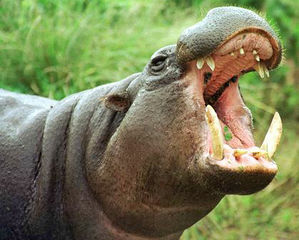 Pygmy Hippopotamus. Source: David Bygott/EoL The lower coastal delta is comprised of a portion of the Central African mangroves ecoregion. There are five species of mangrove trees that dominate the canopy here: Black Mangrove (Avicennia germinans), White Mangrove (Laguncularia racemosa) and three Red Mangroves, Rhizophora racemosa, R. mangle, and R. harrisonii. Notable mammals in the mangroves are: the Vulnerable marine mammal West African Manatee (Trichechus senegalensis, VU), the Spotted-necked Otter (Hydrictis maculicollis), the near-endemic Sclater's Monkey (Cercopithecus sclateri), and isolated populations of Pygmy Hippopotamus (Hexaprotodon liberiensis heslopi, VU).
Pygmy Hippopotamus. Source: David Bygott/EoL The lower coastal delta is comprised of a portion of the Central African mangroves ecoregion. There are five species of mangrove trees that dominate the canopy here: Black Mangrove (Avicennia germinans), White Mangrove (Laguncularia racemosa) and three Red Mangroves, Rhizophora racemosa, R. mangle, and R. harrisonii. Notable mammals in the mangroves are: the Vulnerable marine mammal West African Manatee (Trichechus senegalensis, VU), the Spotted-necked Otter (Hydrictis maculicollis), the near-endemic Sclater's Monkey (Cercopithecus sclateri), and isolated populations of Pygmy Hippopotamus (Hexaprotodon liberiensis heslopi, VU).
Five threatened marine turtle species are found in the mangroves of the lower coastal delta: Leatherback Sea Turtle (Dermochelys coricea, EN), Loggerhead Sea Turtle (Caretta caretta, EN), Olive Ridley Turtle (Lepidochelys olivacea, EN), Hawksbill Sea Turtle (Eretomychelys imbricata, CR), and Green Turtle (Chelonia mydas, EN).
Other reptiles found here are the Nile Crocodile (Crocodylus niloticus), African Softshell Turtle (Trionyx triunguis), African Rock Python (Python sebae), Boomslang Snake (Dispholidus typus), Cabinda Lidless Skink (Panaspis cabindae), Neon Blue Tailed Tree Lizard (Holaspis guentheri), Fischer's Dwarf Gecko (Lygodactylus fischeri), Richardson's Leaf-Toed Gecko (Hemidactylus richardsonii), Spotted Night Adder (Causus maculatus), Tholloni's African Water Snake (Grayia tholloni), Smith's African Water Snake (Grayia smythii), Small-eyed File Snake (Mehelya stenophthalmus), Western Forest File Snake (Mehelya poensis), Western Crowned Snake (Meizodon coronatus), Western Green Snake (Philothamnus irregularis), Variable Green Snake (Philothamnus heterodermus), Slender Burrowing Asp (Atractaspis aterrima), Forest Cobra (Naja melanoleuca), Rough-scaled Bush Viper (Atheris squamigera), and Nile Monitor (Varanus niloticus).
Fish species
There are 268 native taxa of fishes recorded in the Niger Basin, including a number of basin endemics, especially in the family Mochokidae (or upside-down catfishes). The benthopelagic basin endemic Kurungu (Synodontis guttata) is a 79 centimetre fish known only to the type locality in the lower Niger River mainstem. Another endemic upside-down catfish is the 35 cm benthopelagic Folashe, common name derived from the Hausa language, (Synodontis resupinatus), is found only in the Niger mainstem and the tributary Benue River. The 61 cm benthopelagic basin endemic Synodontis vermiculata is found only within the Niger River in the Mopti region and from Lake Kainji. The small demersal fish Cameroon Fine (Zaireichthys camerunensis) is endemic to the Niger Basin, including the upper mainstem and the tributary Benue River. Another rare species is the 14 cm Niger River Basin endemic Trunkfish (Mormyrops oudoti), which is known only by the type specimen found in Bamako, Mali from the Niger mainstem.
Some of the larger native, but non-endemic demersal fishes in the Niger Basin are the 116 cm Tiger Fish (Hydrocynus vittatus); the near-endemic 231 cm Niger Stingray (Dasyatis garouaensis), which occurs in the Cross and Sanaga Rivers as well as the Niger Basin; the 124 cm Silver Catfish (Bagrus bajad); the 102 cm Moon Fish (Citharinops distichodoides); the 110 cm Clarias buthupogon.
Larger native benthopelagic fishes found in the Niger River Basin include the 165 cm Giant Sea Catfish (Arius gigas), which can tolerate fresh as well as saline water, and thus migrates considerable distances upriver from the coastal delta. The Giant Sea Catfish is found only in the Niger and Volta River basins. The large 124 cm electric catfish taxon Mijiriya (Malapterurus minjiriya) is also found in the Niger Basin.
Pelagic fishes found in the lower coastal Niger Delta include the Shortbody Sardine (Sardinella maderensis), Flat Needlefish (Ablennes hians), Senegal Needlefish (Strongylura senegalensis), Atlantic Tarpon (Megalops atlanticus), West African Ladyfish (Elops lacerta), Senegalese Ladyfish (Elops senegalensis) and the Bonefish (Albula vulpes).
Conservation
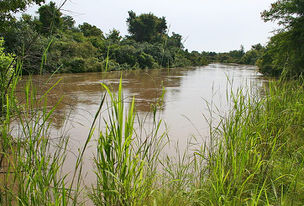 Mekrou River in the W Transborder Park. Source: Marco Schmidt There are several protected areas in the Niger Basin; however, many suffer from inadequate enforcement and the pressures of an expanding indigneous population. For example, the W Transborder Park is established around a "W" shaped meander in the Niger River, where the Mekrou River discharges. This UNESCO site has been steadily degraded for lack of adequate protection; for example, this was the locus of prior packs of the Endangered African Painted Hunting Dog (Lycaon pictus), before they were locally extirpated by illegal hunting by indigenous peoples.
Mekrou River in the W Transborder Park. Source: Marco Schmidt There are several protected areas in the Niger Basin; however, many suffer from inadequate enforcement and the pressures of an expanding indigneous population. For example, the W Transborder Park is established around a "W" shaped meander in the Niger River, where the Mekrou River discharges. This UNESCO site has been steadily degraded for lack of adequate protection; for example, this was the locus of prior packs of the Endangered African Painted Hunting Dog (Lycaon pictus), before they were locally extirpated by illegal hunting by indigenous peoples.
The Lake Kainji National Park surrounds the manmade Lake Kainji in the lower reach, but this site suffers overfishing for human subsistance, illegal poaching of wildlife, illegal overgrazing and illegal deforestation.
The Edumanom Forest Reserve is a freshwater habitat in the Niger Delta, and represents one of the last strongholds of the Chimpanzee. This site is threatened by deforestation by indigenous peoples and illegal hunting. There are few roads present, so that enforcement activities are severely hindered.
References
- E.A. Ajao. 1993. Mangrove ecosystems in Nigeria. In E.D. Diop, editor. Conservation and Sustainable Utilization of Mangrove Forests in Latin America and Africa Regions. Part II, Africa. International Society for Mangrove Ecosystems and Coastal marine Project of UNESCO. Mangrove Ecosystems Technical Reports volume 3.
- Fishbase. 2011. Fish species in the Niger Basin
- J..-P. Gosse. 1986. Mochokidae. p. 105-152. In J. Daget, J.-P. Gosse and D.F.E. Thys van den Audenaerde (eds.) Check-list of the freshwater fishes of Africa (CLOFFA). Brussels, MRAC, Tervuren; and ORSTOM, Paris. Vol. 2.
- D.C.D. Happold, 1987. The mammals of Nigeria. Oxford University Press, Oxford. ISBN: 0198575653
- C. Michael Hogan. 2013. Amietophrynus chudeaui. African Amphibians. ed. Breda Zimkus
- C.Michael Hogan .2009. Painted Hunting Dog: Lycaon pictus, IGoTerra.com, ed. N. Stromberg
- R.C.C. Law. 1967. The Garamantes and Trans-Saharan Enterprise in Classical Times. The Journal of African History 8 (2): 181–200
- F. White. 1983. The vegetation of Africa, a descriptive memoir to accompany the UNESCO/AETFAT/UNSO Vegetation Map of Africa (3 Plates, Northwestern Africa, Northeastern Africa, and Southern Africa, 1:5,000,000). UNESCO, Paris.
